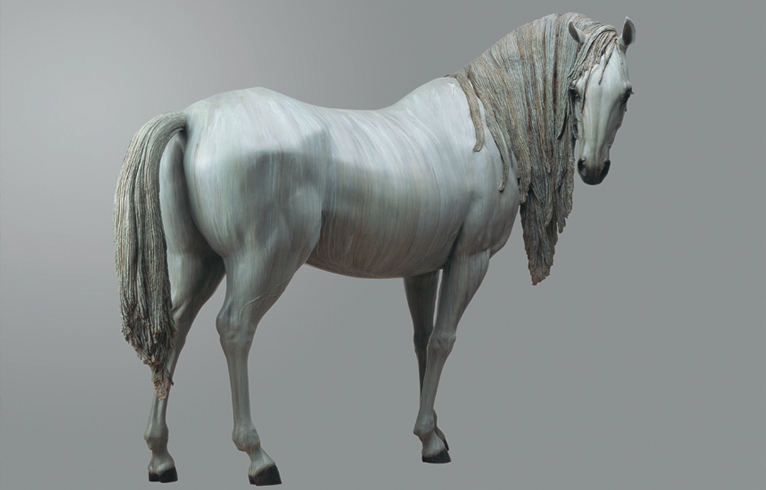XIANG JING: WILL THINGS EVER GET BETTER?
| February 20, 2012 | Post In LEAP 12

Following the exhibition, nearly all press coverage of “Will Things Ever Get Better?” referred to the figure of the horse. At the show, the horse was portrayed as utterly dejected and sad, bearing the look of intense scrutiny and existential doubt typical of a philosopher. Even though the portrayal of this slim yet hearty-looking horse is truly that of an inspired work, when everyone’s gaze is completely fixed only on it, the significance of the exhibition as a whole gets overlooked.
This exhibition was roughly divided by a piece of dark red flannel almost ten meters tall into two independent, opposing spaces. Evidently, due to some clever configuration, by far the better works in the main gallery were those farthest back from the curtain. We can surmise that precisely because of the limits of the space itself, many of the animals behind the curtain— the seal, the horse, and the giraffe— were just thrown carelessly in a straight line, completely failing to achieve the effect of the artist’s original intention. Without a doubt, the figure of the horse sculpture, taken alone, is very much in line with the question, “Will things ever get better?” So are the thematic, philosophical, and tragic qualities embodied by the underlying text. Along this train of thought is the idea that thematic composition directs people’s attention toward this or that work— but this is mass media’s, and even specialized media’s, understanding of contemporary art.
In this exhibition, Xiang Jing’s is more of a theatrical space, an intention that leads us to transcend the conventional appreciation of modernist sculpture. Just as with the horse, modernism has a fixed, absorbed gaze. But Xiang still tries hard, through the arrangement of the space, to draw you into a state of dissociation and vacillation, one of shifting gaze and experience. To this end, she has erected a wooden bridge in the exhibition, and on both sloping and level parts of the ground in different corners throughout the exhibition, she placed callous and indifferent acrobat understudies. As such, we play the role of audience, but we are also given three layers of perspective: the view of the fixed gaze, the view from the bridge, and the view among and behind the performers. These various perspectives are all pre-arranged and executed under Xiang’s guidance, yet only if we take the initiative to cooperate with the artist— and simultaneously adjust to the different conditions for the observation of objects— can we succeed in achieving maximum liberation from the various ways we are affected by the show. Xiang’s exhibition is one about spaces. There is a distinct immediacy to this technique, demanding not only that the artist have the ability to coordinate multiple spaces, but also that the audience possess the ability to understand and experience multiple spaces.
Yet what is most affecting about this exhibition lies in the ubiquitous calm of the space. It is similar to the strong European character embodied by the works of sculptors Walter Moroder and Willy Verginer, who were from almost the same time period. The commonality among the three lies in their ability to use a given space to represent the human condition, sometimes through an attentive gaze, other times through a face. But for Xiang Jing, asking the question “Will things ever get better?” is an extension of her own physicality. In her first breakthrough work, the anguish of a little girl and the terrified look in her eyes were a transmission of the artist’s own suffering. And in the rigid, false smiles of these acrobats, what we see, then, is the artist’s negative vision of the world. They have a shared foundation in fear, pessimism, and insecurity, and they are precisely what compel us to have compassion for humanity. Po Hung (Translated by Caly Moss)


